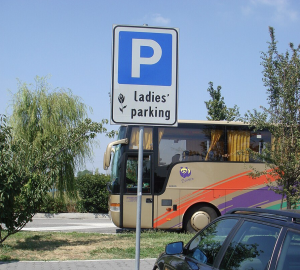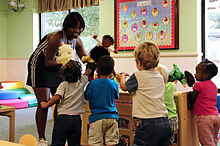Chapter 7: Race and Ethnicity
7.5 Identity – Race, Ethnicity, Gender
Gender, race, and ethnicity significantly impact one’s experience and perception of place in the geographic sense. These social categories shape not only personal identity but also the spatial dynamics of communities, access to resources, and socio-economic opportunities.
Gender and Place

Source: “Ladies-only parking lot in Brescia, Italy” by Bolo77 via Wikimedia Commons.
Gender influences how individuals interact with their environment, access public spaces, and experience safety. Urban design and infrastructure often reflect gender biases, impacting mobility and access. For instance, women may face challenges related to safety in poorly lit areas, leading to restricted movement. This is particularly true in dark parking garages or on huge deserted parking lots. Germany was the first country to institute parking for females in 1990 and in some regions it even became law that 30% of the spaces were reserved for women. China and Korea also adopted such policies. Public spaces and amenities, such as restrooms and parks, may also be designed with gender-specific needs in mind, affecting how different genders experience and use these places.

Source: “Riad Laaroussa in Fes” by Paola Gamba via Wikimedia Commons is licensed under CC BY 2.0.
In many Arab countries, traditional houses are designed with courtyards that significantly influence architectural layouts, particularly with women in mind. These courtyards provide private, open-air spaces where women can freely engage in daily activities, socialize, and enjoy the outdoors while maintaining cultural norms of modesty and privacy. The architectural design ensures that these inner sanctuaries are shielded from public view, often surrounded by high walls and intricately carved wooden screens, allowing for natural ventilation and light. This layout not only fosters a safe and comfortable environment for women but also enhances the aesthetic and functional aspects of the home, reflecting a harmonious blend of cultural values and practical living. In certain parts of the world, women may wear an abaya and head covering, and yet feel safer and freer than some women in the West.

Source: “A 28-member farming group in Machakos, Kenya farms” by McKay Savage via Wikimedia Commons is licensed under CC BY 2.0.
In low-income countries, women often engage in unpaid agricultural labor and are primarily responsible for raising children. They play a crucial role in subsistence farming, working long hours in the fields to grow food for their families without monetary compensation. This labor is essential for household survival but is frequently unrecognized and undervalued. They face a number of challenges with patriarchal societies frequently limiting how much agency and control women in agricultural communities have over their own labor. Additionally, these women are the primary caregivers, managing household chores, and ensuring the upbringing and education of their children, often with limited access to resources such as healthcare and education.

Source: “restwood High School varsity cheerleading captain MicKayla Ketter plays with toddler class” by Airman 1st Class Hunter Brady via Wikimedia Commons is in the public domain.
In contrast, in higher-income countries, women are more likely to participate in the formal labor market, often balancing their careers with family responsibilities. These women frequently utilize childcare services to support their employment, entrusting their children to professional caregivers or childcare centers during working hours. This enables them to pursue various career opportunities, contributing to household income and achieving financial independence. Access to reliable childcare, parental leave policies, and flexible work arrangements are critical factors that facilitate women’s participation in the workforce in higher-income countries.
The contrast between these two scenarios highlights the significant disparities in gender roles and economic opportunities. Women in low-income countries face the dual burden of unpaid labor and caregiving responsibilities, limiting their economic mobility and perpetuating cycles of poverty. In higher-income countries, while women still face challenges in balancing work and family life, they generally have more access to resources and support systems that enable them to pursue paid employment and career advancement. Nevertheless they often have a double burden of child-raising and work as well depending on the finances of the household. Addressing these disparities requires targeted policies and interventions that recognize and support the diverse roles of women in both low and high-income settings.
Race and Place
Historical processes like colonization, slavery, and segregation have left lasting imprints on the geographic distribution of racial groups in the United States and elsewhere in the New World. These histories shape contemporary racial identities and the collective memory of places. Neighborhoods, cities, and even entire regions, i.e. along the lower Mississippi, can carry the legacy of racial segregation, influencing how different racial groups relate to these places and to each other.
Race often affects access to social and economic opportunities, such as education, employment, housing, and healthcare. For instance, systemic racism can lead to the concentration of racial minorities in under-resourced neighborhoods with poorer living conditions and fewer opportunities for upward mobility. These disparities shape the experiences and identities of individuals within these racial groups, reinforcing social hierarchies and influencing aspirations and life choices.
Experiences of discrimination and marginalization based on race and also on ethnicity profoundly impact how individuals perceive their place in society. Encounters with racism in public spaces, workplaces, and institutions can lead to feelings of exclusion and insecurity. These negative experiences shape identity by reinforcing a sense of otherness and influencing how individuals navigate and interact with their environments.
Ethnicity and Place

Source” “View of the neighborhood of Jackson Ward, in Richmond, Virginia.” by Morgan Riley via Wikimedia Commons is licensed under CC BY 3.0.
Both, race and ethnicity contribute to the creation of cultural landscapes and community dynamics. Ethnic enclaves, such as Chinatown, Little Italy or African American cultural districts, reflect the concentration of specific ethnic groups in certain areas, creating vibrant cultural hubs. It is in these spaces where racial and ethnic identities are celebrated and preserved.These neighborhoods provide a sense of belonging and support for ethnic communities, preserving cultural practices and languages. fostering pride in one’s heritage while also creating spaces that are distinct from the broader societal contexts. However, ethnic minorities may also face challenges such as discrimination, social exclusion, and limited access to broader economic opportunities, impacting their geographic mobility and quality of life.
Intersectionality and Place
The intersection of gender, race, and ethnicity further complicates the experience of place. Women of color, for example, may face compounded disadvantages due to both racial and gender biases. Immigrant women might encounter language barriers, discrimination, and economic exploitation, affecting their ability to navigate and thrive in their new environments. These intersecting identities influence how individuals experience and shape their environments, leading to diverse and nuanced understandings of place.
Conclusion
Gender, race, and ethnicity are pivotal in shaping geographic experiences and opportunities. The experience of place varies significantly across urban and rural environments, and between low and high-income countries. Addressing spatial inequalities rooted in social categories necessitates thoughtfully planned cultural change. In urban areas of high-income countries, comprehensive and inclusive urban planning can be employed to recognize and meet the diverse needs of all community members.

